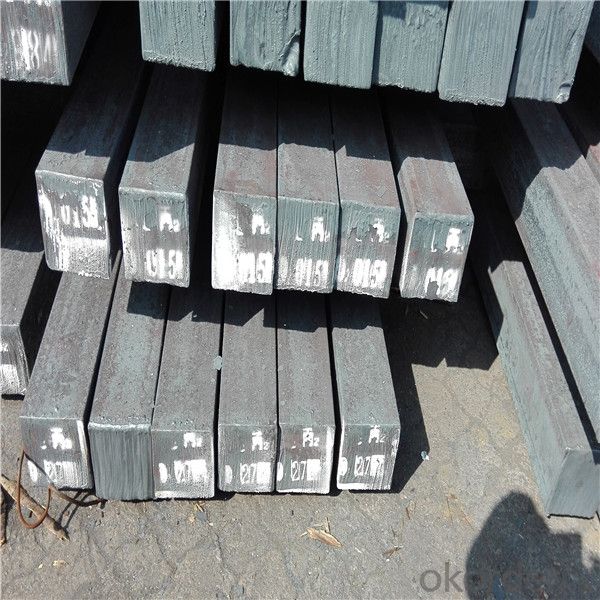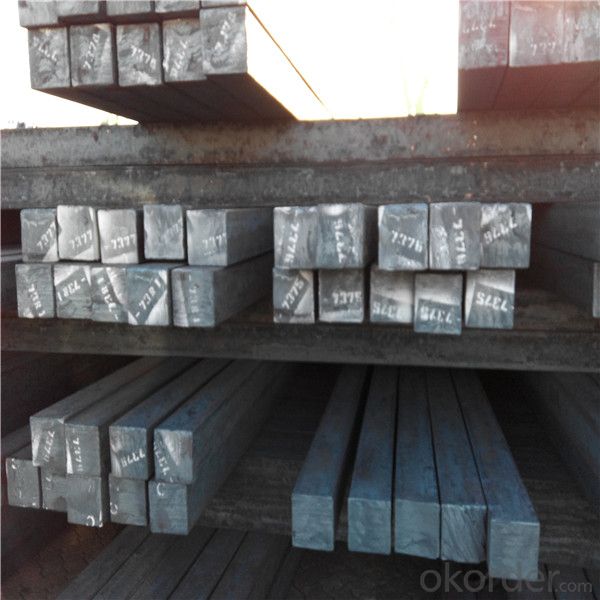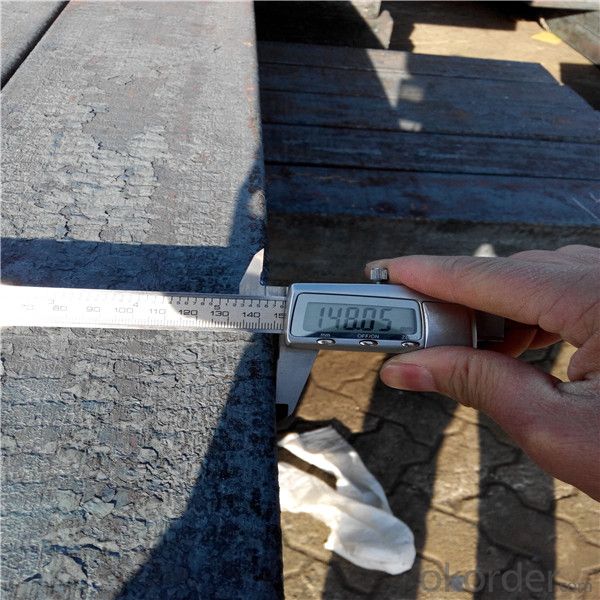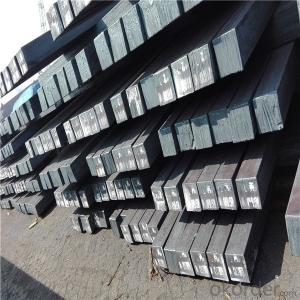Alloy Steel billets for sale Q195/Q215 China
- Loading Port:
- Tianjin
- Payment Terms:
- TT OR LC
- Min Order Qty:
- 1000 m.t.
- Supply Capability:
- 15672 m.t./month
OKorder Service Pledge
OKorder Financial Service
You Might Also Like
Item specifice
Rectangular billet continuous casting billet and mainly general carbon steel, low carbon low silicon cold-rolled material, high quality carbon structural steel, high strength low alloy steel, special steel, etc.
The billet is mainly divided into two kinds from the shape:
Slab: cross section width and height of the ratio of the larger, mainly used for rolling plate.
The billet is mainly divided into two kinds from the shape:
Slab: cross section width and height of the ratio of the larger, mainly used for rolling plate.
Size :100mm to 165mm
Length:6~12meters
Grade: Q195/Q215/Q235/Q275
Qaulity:own factory, stable quality
Tolerance: Strictly according to the G/B and JIS standard
Gade:
Standard | C(%) | Mn(%) | S(%) | P(%) | Si(%) |
Q195 | ≤0.12 | ≤0.50 | ≤0.040 | ≤0.035 | ≤0.30 |
Q235 | ≤0.20 | ≤1.40 | ≤0.045 | ≤0.045 | ≤0.35 |
Q275 | ≤0.22 | ≤1.50 | ≤0.045 | ≤0.045 | ≤0.35 |
20MnSi | 0.17-0.25 | 1.2-1.6 | ≤ 0.050 | ≤ 0.050 | 0.40-0.80 |
3SP | 0.14-0.22 | 0.40-0.85 | ≤ 0.050 | ≤ 0.040 | 0.05-0.15 |
5SP | 0.28-0.37 | 0.50-1.00 | ≤ 0.050 | ≤ 0.040 | 0.15-0.30 |




Our service :
We have a plant and professional team to provide our best service, from the start of production until the
loading into the vessel, we have a complete quality follow up procedure, to assure our products arrives to the customer with satisfaction. Welcome new and old customers
to contact us for future business relationships! We will give you a surpise price.
Packing :
Within 30 days
1.Standard export package
2.In bundles with steel strips
3.As the requirements of the customers
FAQ:
Q: What is payment terms?
A: FOB 30% T/T IN ADVANCE AS DEPOSIT AND 70% T/T BEFORE SHIPMENT
CIF and CFR 30% T/T IN ADVANCE AS DEPOSIT AND 70% T/T AS THE COPY OF B/L OR L/C AT SIGHT
Q:How to guarantee the quality of the products?
A:We have established the international advanced quality management system,every link from raw material
to final product we have strict quality test;We resolutely put an end to unqualified products flowing into the market.
At the same time, we will provide necessary follow-up service assurance.
Q:How long can we receive the product after purchase?
A :In the purchase of product within three working days, We will arrange the factory delivery as soon as possible.
The pecific time of receiving is related to the state and position of customers.
- Q:How are steel billets used in the production of marine equipment?
- Steel billets play a vital role in the production process of marine equipment. These semi-finished steel products serve as the raw material for manufacturing various components used in the construction of marine equipment, such as ships, offshore platforms, and marine structures. Initially, steel billets are utilized to fabricate different structural elements of marine equipment, including hulls, decks, and bulkheads. These components provide the necessary strength and stability to withstand the harsh marine conditions. Through processes like rolling, forging, or extrusion, the billets are heated and shaped into the desired sizes and shapes of these structural elements. Furthermore, steel billets are employed in the production of propeller shafts, rudders, and other components of propulsion systems. These parts are crucial for the movement and maneuverability of marine equipment. The billets undergo machining and further processing to create these specialized components, ensuring their durability and reliability in demanding marine conditions. Additionally, steel billets are also used in the manufacturing of marine equipment accessories, such as anchors, chains, and mooring systems. These accessories play a vital role in ensuring the stability and safety of vessels and offshore structures. Through casting, forging, or machining processes, the billets are transformed into the required shapes and sizes to meet the specific requirements of each accessory. Moreover, steel billets are essential in the production of marine equipment fittings, including valves, pipes, and fittings for fluid and gas systems. These components are crucial for the proper functioning of various systems on board vessels, such as fuel, water, and hydraulic systems. The billets undergo processing and machining to create these fittings, ensuring their compatibility with marine-grade materials and their ability to withstand corrosive marine environments. In conclusion, steel billets are indispensable in the production of marine equipment. They serve as the primary raw material for creating structural elements, propulsion system components, accessories, and fittings. By using steel billets, manufacturers can ensure the strength, durability, and reliability of marine equipment, enabling them to withstand the challenging conditions of the marine environment and ensure the safety and performance of vessels and offshore structures.
- Q:How are steel billets used in the manufacturing of rail tracks?
- Steel billets are an essential component in the manufacturing of rail tracks. A billet is a semi-finished piece of steel that is commonly used as a starting material in various metalworking processes. In the case of rail track manufacturing, steel billets are first heated to a high temperature and then passed through a series of rolling mills. During the rolling process, the steel billets are gradually shaped and elongated to form long, narrow sections known as rail blooms. These rail blooms are then further processed and shaped through hot rolling, where they are passed through multiple sets of rollers to achieve the desired dimensions and shape of the rail track. This process helps in improving the mechanical properties of the steel, such as its strength and durability. Once the rail blooms are shaped, they undergo a process called controlled cooling, where they are cooled at a specific rate to optimize their microstructure and properties. This controlled cooling helps in reducing internal stresses and improving the overall quality of the rail tracks. After the controlled cooling process, the rail blooms are further processed through straightening, cutting, and finally, finishing operations. These operations ensure that the rail tracks are straight, have precise dimensions, and meet the required standards and specifications. In summary, steel billets play a crucial role in the manufacturing of rail tracks. They are transformed into rail blooms through a series of rolling processes, and then further processed to produce high-quality rail tracks that are strong, durable, and able to withstand the heavy loads and constant use of railway transportation systems.
- Q:What are the main challenges in the production of steel billets?
- The main challenges in the production of steel billets include maintaining consistent quality and dimensional accuracy, ensuring proper heat treatment and cooling processes, minimizing defects and surface imperfections, managing energy consumption and environmental impact, and meeting the growing demand for sustainable and cost-effective production methods. Additionally, the industry faces challenges related to raw material availability and cost fluctuations, as well as competition from alternative materials and technologies.
- Q:How is the demand for steel billets projected to change in the future?
- The demand for steel billets is expected to experience significant changes in the future due to various factors. One of the primary drivers of this change is the overall growth of the construction and infrastructure sectors. As economies continue to develop, there will be an increased need for steel billets to support the construction of buildings, bridges, roads, and other infrastructure projects. Additionally, the automotive industry is also anticipated to contribute to the changing demand for steel billets. With the rising demand for electric vehicles and the need for lightweight materials to improve fuel efficiency, steel billets may be replaced by alternative materials such as aluminum or carbon fiber in certain automotive applications. Furthermore, the renewable energy sector is another potential factor that could impact the demand for steel billets. As the world moves towards cleaner energy sources, there will be a growing requirement for wind turbines and solar panels, which are predominantly made from steel. This could lead to an increase in demand for steel billets in the manufacturing of these renewable energy components. On the other hand, advancements in technology and manufacturing processes may also influence the demand for steel billets. As new techniques and materials are developed, there is a possibility of steel billets being substituted by alternative materials or manufacturing methods that offer superior performance or cost-efficiency. Overall, while the demand for steel billets is expected to remain strong in the foreseeable future, it may undergo changes based on the growth of construction, infrastructure, automotive, and renewable energy sectors, as well as advancements in technology and materials.
- Q:What is the standard tolerance for steel billet dimensions?
- The standard tolerance for steel billet dimensions can vary depending on the specific industry and application. However, commonly accepted tolerances for steel billet dimensions typically range from +/- 0.5% to +/- 2% of the specified dimensions.
- Q:How are steel billets used in the production of mining conveyors?
- Steel billets are used in the production of mining conveyors as they serve as the raw material for manufacturing various components such as frames, supports, and conveyor belts. These billets are heated, shaped, and machined to create the required parts that are strong, durable, and capable of withstanding the harsh conditions of the mining environment.
- Q:What are the different types of steel billet surface treatments?
- There are several different types of steel billet surface treatments, including pickling, shot blasting, and painting. Pickling involves removing impurities and oxides from the surface of the billet using an acid solution. Shot blasting is a process in which small metallic or abrasive particles are blasted onto the surface of the billet to remove rust, scale, and other contaminants. Painting involves applying a protective coating or layer of paint to the surface of the billet to prevent corrosion and improve its appearance.
- Q:How are steel billets used in the energy and power generation industry?
- Steel billets are used in the energy and power generation industry for various purposes such as manufacturing turbine blades, generator parts, and structural components of power plants. These billets are essential in creating strong and durable equipment that can withstand the demanding conditions and high temperatures associated with energy production.
- Q:How are steel billets used in the manufacturing of castings?
- Steel billets are an important raw material in the manufacturing of castings. Castings are solid metal objects that are formed by pouring molten metal into a mold and allowing it to cool and solidify. Steel billets are typically used as the starting material for this process. To create castings, steel billets are first heated to a high temperature until they become molten. This molten steel is then poured into a mold, which is typically made of sand or metal. The mold is designed to have the desired shape and dimensions of the final casting. Once the molten steel is poured into the mold, it is left to cool and solidify. As the steel cools, it takes on the shape of the mold, forming the desired casting. The cooling process is critical as it determines the strength, hardness, and other mechanical properties of the final product. After the steel has solidified, the mold is removed, and the casting is cleaned and finished. This may involve removing any excess material, such as gates or risers, that were used to facilitate the pouring of the molten metal. The casting may also undergo additional processes, such as machining or heat treatment, to achieve the desired final specifications. In summary, steel billets are used in the manufacturing of castings by being melted and poured into a mold to create the desired shape. The cooling and solidification of the molten steel within the mold results in the formation of a solid casting, which can then be further processed and finished as required.
- Q:What are the different types of defects that can occur during steel billet production?
- During steel billet production, various types of defects can occur that may affect the quality and performance of the final product. Some of the common defects observed in steel billets are: 1. Surface Defects: These defects occur on the surface of the billet and can include scales, cracks, pits, scars, and slivers. Surface defects can be caused by improper handling, poor lubrication, inadequate heating, or contamination during the manufacturing process. 2. Internal Defects: Internal defects occur within the billet and can be more challenging to detect. Examples of internal defects include voids, porosity, inclusions, and segregation. Internal defects can arise due to improper alloying, inadequate mixing, or improper casting and solidification processes. 3. Shape Defects: Shape defects refer to any deviation from the desired dimensions or geometry of the billet. These defects can include bending, bowing, twisting, or excessive tapering. Shape defects can be caused by improper rolling or cooling processes, inadequate maintenance of rolling equipment, or poor billet handling. 4. Chemical Composition Defects: Steel billets must meet specific chemical composition requirements to ensure desired material properties. Defects in chemical composition can occur due to improper mixing of raw materials, incorrect temperature control, or contamination during the manufacturing process. These defects can negatively impact the mechanical properties, such as strength, ductility, or corrosion resistance, of the final product. 5. Incomplete Solidification: Incomplete solidification can lead to defects like centerline segregation or shrinkage cavities. These defects occur when the cooling rate is too fast or uneven, preventing the complete solidification of the billet. Incomplete solidification can weaken the billet structure, affecting its overall integrity and performance. 6. Dimensional Defects: Dimensional defects refer to deviations in the size, length, width, or thickness of the billet. These defects can occur due to inaccurate measurement or control during the manufacturing process. Dimensional defects can impact the fitment or compatibility of the billet in subsequent processes or applications. It is crucial for steel billet manufacturers to implement stringent quality control measures to minimize the occurrence of these defects. Regular inspections, process optimization, and adherence to industry standards and best practices can help mitigate defects and ensure the production of high-quality steel billets.
1. Manufacturer Overview |
|
|---|---|
| Location | |
| Year Established | |
| Annual Output Value | |
| Main Markets | |
| Company Certifications | |
2. Manufacturer Certificates |
|
|---|---|
| a) Certification Name | |
| Range | |
| Reference | |
| Validity Period | |
3. Manufacturer Capability |
|
|---|---|
| a)Trade Capacity | |
| Nearest Port | |
| Export Percentage | |
| No.of Employees in Trade Department | |
| Language Spoken: | |
| b)Factory Information | |
| Factory Size: | |
| No. of Production Lines | |
| Contract Manufacturing | |
| Product Price Range | |
Send your message to us
Alloy Steel billets for sale Q195/Q215 China
- Loading Port:
- Tianjin
- Payment Terms:
- TT OR LC
- Min Order Qty:
- 1000 m.t.
- Supply Capability:
- 15672 m.t./month
OKorder Service Pledge
OKorder Financial Service
Similar products
New products
Hot products
Hot Searches
Related keywords





























